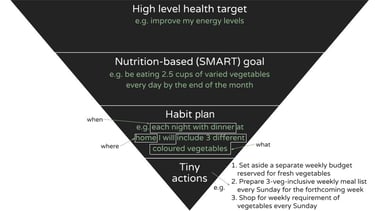The only constant is change...unless you're struggling to make one
Every human who has ever existed has been challenged by changing or creating new habits. There is a psychological reason for this (stay tuned for next month's blog post - packed full of habit formation tips), and health habits are certainly not exempt from this obstacle.
We have all been there in the weeks and months following January 1st. We had such good intentions for the fresh, new year - a blank slate to make all our dreams come true! But we can't seem to stick to it, or what we're sticking to doesn't actually help us achieve our ultimate goals. Once again, just like previous years, we are underwhelmed by our results.
From this experience, we all intuitively know that just making the decision and then seeing how far we can push our willpower doesn't cut the mustard. We need a process underpinned by practical actions that take us step-by-step. A significant part of this is doing some internal questioning to determine why the change is important to us, clarifying what the change actually looks like, and then establishing small, achievable steps that will get us to the ultimate objective. One term for the latter is 'shrinking the change'.
Let's begin with 'why'...
Each of us has very different health goals, and we don't always stop to think very long about the deeper reasons for which we want to achieve them. Why are they important to us? Like, not superficially, but REALLY why are they important to us?
Like all facets of life, we are each driven by unique motivations when it comes to what we want to achieve with our health. You may want to invest in your health to have lots of energy for your family, to improve or maintain your physical appearance, for life longevity or simply to feel great every day - or for a completely different reason altogether. This is your 'why'.
Your ‘why’ is the most powerful tool you have to keep making progress. It serves as a motivating reminder whenever you doubt the efforts you are making to achieve your health goals, feel unmotivated or notice yourself getting off track.
Framing your goal for success
It goes without saying that we first need to know where we want to end up to determine how to get there. Just like your ‘why’, your vision of what a healthy you looks and feels like will differ from that of others.
One way to get really clear on what our tangible goals are is to frame them as SMART goals.
The SMART criteria is a way to formulate goals, including health goals. SMART goals lead to more effective outcomes than intangible, loosely defined desires, because they are targeted and relevant to our individual long-term vision of success. The SMART acronym stands for:
Specific - Goals that are specific and clearly defined create a clearer pathway to achievement, e.g. ‘I want to get 8 hours of sleep every night’ is more specific than ‘I want to sleep better’.
Measurable - If you cannot measure a goal how will you know when you have achieved it? Assigning a measurable metric to your goal means that you are certain of success and you can then move onto the next goal once you reach it.
Achievable - Setting unrealistic goals that we will never be able to achieve will only serve to demotivate us. On the contrary, it is hugely motivating to set smaller, more achievable goals that we can actually accomplish and then build on.
Relevant - There should be a clear and obvious pathway from the goal to your broader objectives. Goals should help you achieve what you actually care about accomplishing, rather than wasting time on activities that will not get you closer to where you want to be.
Time-bound - A realistic deadline both gives you a clear timeline to work towards and ensures you remain accountable to achieving success.
6 tips for developing effective SMART goals
Start small and work your way up
If your ultimate goal is too big to fit into the SMART criteria, or will take too long to achieve, break that goal up into smaller objectives that you can tackle one at a time.
Don’t confuse ‘achievable’ with ‘easy’
Or use this criterion as an excuse to set goals that will not move the needle on your health. Aim high but not so high that you set yourself up for failure.
However you plan to measure your goal, make it as clear and simple as possible
Ensure the measure is quick and easy to discern and does not require any subjective or complex calculations.
When you have achieved your goal, make sure you reward yourself!
Decide on your reward when you set the goal, and make sure it is a celebration that is health-enhancing so that you don’t undo your good work.
Stay positive
If you don't achieve your goal, don't get too disheartened. Simply make the necessary adjustments and keep moving forward.
Be willing to ask for support
If in doubt, get help from somebody who has experience in setting SMART goals. Seek out and embrace opportunities to ‘workshop’ your ideas with others.
Shrinking your change
So by now we are clear on exactly what we want to achieve and why we want to achieve it. The obvious question is: 'Okay, but HOW do I realistically reach this goal?'
Obviously, intentions are useless without action, so it is vital to bridge the gap between where we want to end up and how we will actually get there. Making these behavioural shifts may sound daunting when focusing only on the end goal, but we can increase our chances of success by shrinking the big change down into tiny actions that we can track and celebrate every day. With persistence and consistency, they will eventually become second nature.
Shrinking the change looks like this:
You can see in the above example...
We have gone from a whopper of a goal - improving energy levels - all the way down to teeny tiny, achievable actions that can be consistently scheduled into our weekly activities - such as a shopping task - that we KNOW will ultimately contribute to our overarching target.
This model can be applied to any of the goals that you identify as important to you. Try it out - start the process today!
Happy shrinking!
Sources
Bailey, R. R. (2012) 10.1177/1559827617729634
Fox, N. J. & Ward, K. J. (2008) DOI: 10.1111/j.1467-9566.2008.01093.x
Gardner, B. et al (2012) DOI: 10.3399/bjgp12X659466
Gardner, B. et al (2021) DOI: 10.1080/08870446.2021.2003362
https://www.psychologytoday.com/us/blog/the-truisms-wellness/201610/the-science-accomplishing-your-goals
Schuster, T. L. et al (2004) DOI: 10.1089/107555304323062347
© Sharon Jenner 2023






